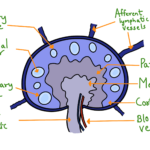Flower development in plants is governed by flowering genes. Flowering genes in plants are of two types, floral meristem identity genes, and floral organs identity genes. The floral organ identity genes fall under the category of homeotic genes with the MADS-box DNA binding domain. Floral identity genes directly control floral identity by giving rise to different floral whorls in flowers. The interaction between these genes determines the whorl of the flower. Typically a flower consists of four whorls from outside of the flower to the inside I) Sepals II) Petals III) Stamen IV) Carpel. Sepal is the outermost whorl and carpel is the innermost. Five genes fall under the category of Floral Identity Genes APETELA 1(AP1), APETELA 2(AP2), APETELA 3(AP3), PISTILATA (PI), and AGAMOUS(AG). The proteins encoded by these genes are transcription factors that control the expression of other genes involved.

The floral development due to the expression of these homeotic genes can be explained by a model known as the ABC model of flower development. According to this model floral development genes are classified into three types. The type A genes include AP1 and AP2 genes, Type B genes include AP3 and PI genes while Type C includes just one gene AG. Interactions between these different types of genes determine floral whorl development.
In wild type situation, Type A alone determine the expression of genes involved in sepals formation. APETELA 1 and APETELA 2 are the genes that are involved in the formation of sepals. The formation of floral whorl petals is a result of the combined actions of genes of types A and B. That is interactions between genes AP1, AP2, AP3, and PI are responsible for petals formation. The third whorl of flower i.e. stamens is formed by interactions of genes of types B and C. Genes such as AP3, PI, and AG are responsible for the formation of stamens. The last and the innermost whorl of flower i.e. carpel is formed because of the gene product of type C (AG) genes.
| Type | Genes involved |
| A | APETELA 1 (AP1), APETELA 2(AP2) |
| B | APETELA 3 (AP3), PISTILATA (PI) |
| C | AGAMOUS (Ag) |

Mutants formed due to mutations in different types of genes:
In some cases, type A genes may get mutated. In such cases, the flower formed will have the whorls in the following order from outermost to innermost whorl: Carpel Stamen Stamen Carpel. This is due to the absence of type A genes will result in the activity of only Type B and Type C genes.
Mutations in Type B genes result in the development of the flower with the whorls Sepals Sepals Carpels Carpels. This is because only Type A and Type C genes are active.
Mutations in Type C genes result in flower with Sepals Petals Petals Sepals type of flower development as only type A and Type B genes are active.




